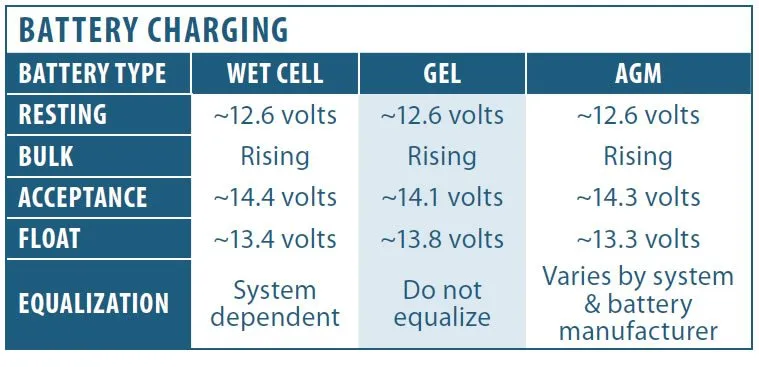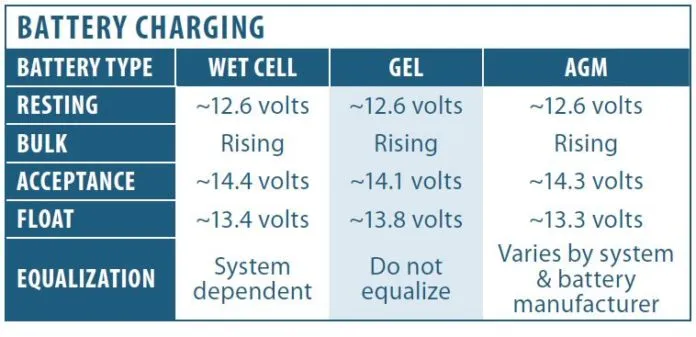Ive had a bunch of friends troubleshooting battery issues lately.It would be really nice to have a chart that shows the battery voltage at rest and charging voltages for bulk/acceptance/float for lead/acid (flooded cells), gel cells, and AGMs.
I know all this info is out there, but when I began searching online for answers, I came up with a ton of hits, and it took a while to sort through all of the information to make sure it was correct.
Jon Bailey
Via www.practical-sailor.com
It doesn’t surprise us that your quick Google search for charging regimens for various types of batteries resulted in an avalanche of information, and that much of it was conflicting. Weve addressed the question of charging regimens many times over the years, and first featured the table you describe (almost identical to the one featured here) more than a decade ago.
Part of the problem is that there is no direct correlation between voltage and ideal charging voltage. Counting on battery voltage to be the sole measure of charging efficiency is like measuring blood pressure and diagnosing an illness from that one piece of data.
Voltage is only one component in the charging equation. Interestingly, battery temperature is in some ways a better measure of how much current can be forced into a battery without overcharging. A sophisticated charging system will track both voltage battery temperature and adjust the charging voltage accordingly.
For example, the absorption voltage in a Lifeline AGM battery at 20 degrees is 15.31 volts, but at 80 degrees, it jumps to 14.27 volts. Most marine battery makers will include in the owners manual a table indicating the ideal charging voltage for various temperatures.
The other problem is the wide variability, even among the same battery types, in the recommended charging voltages. In our report on sulfation in AGM batteries (see PS May 2015 and August 2015 online), we tracked how much capacity a battery loses through partial charge cycles. One of the many headaches of that test was to make sure we precisely followed the regimen recommended by each manufacturer. During our research for that test, we even found different advice for the same exact gel battery, depending on which brand it was being sold under (see PS Advisor June 2015 online).
Each battery manufacturer seems to have a slightly different slant on how and at what voltage their battery should be charged, as well as how the charge tapering should be carried out.
The accompanying table was supplied by technical experts at Xantrex, the maker of one of the battery monitors we are testing for an upcoming report. (Xantrex also makes a wide range of multi-stage chargers, which we reviewed in the February 2010 and March 2010 issues.) The table illustrates the approximate voltages for the various stages of charging by battery type, including equalization or conditioning voltage, used for desulfation. Our best advice is to check with your batterys manufacturer for the most accurate information.
As you try to maximize charging efficiency, it is important to be aware of the dangers of overcharging. Any effort to pump a battery to full charge by applying the most possible current into the shortest possible time carries the risk of destroying a very expensive battery bank. Allowing a slightly longer time allotment, at a little lower than maximum voltage charging rate, usually makes sense in the long run.





































